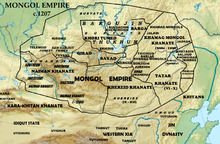Naiman
Tampilan
 Letak Kekhanan Naiman pada permulaan Kekaisaran Mongol. | |
| Daerah dengan populasi signifikan | |
|---|---|
| Bahasa | |
| Subdialek Naiman dari rumpun bahasa Mongolia, Turkic[1][2][3] | |
| Agama | |
| Buddha Tibetan, Shamanisme | |
| Kelompok etnik terkait | |
| Suku Kazakh[4][5][6][7] kemudian Kazakh terMongolisasi[8][9] |
Naiman (Kazakh: Найман[10]; Uzbek: Nayman;[11] Khalkha-Mongolia: Найман/Naiman, "delapan") adalah sebuah suku yang berasal dari Mongolia, salah satu suku juz tengah dari negara Kazakh.
Naiman Modern
[sunting | sunting sumber]Suku Naiman modern adalah sebuah kelompok etnis Mongol[12] di Panji Naiman, Mongolia Dalam, Tiongkok. Klan Naiman mengubah nama klan mereka dan bercampur dengan suku-suku lain di Mongolia.
Referensi
[sunting | sunting sumber]- ^ Man, John (2013). Genghis Khan: Life, Death, and Resurrection. hlm. 19-20.
- ^ Morris Rossabi (2012). The Mongols: A Very Short Introduction. Oxford University Press.
- ^ Frederick W. Mote (2003). Imperial China 900-1800. hlm. 407.
- ^ Frank McLynn (2015). Genghis Khan: The Man Who Conquered the World.
- ^ Michal Biran (2012). Chinggis Khan. Oneworld Publications.
- ^ Joshua Fogel (2012). The Blue Wolf: A Novel of the Life of Chinggis Khan: A Novel of the Life of ... Columbia University Press. hlm. 102.
- ^ John Joseph Saunders (2002). A History of Medieval Islam.
- ^ René Grousset. The Empire of the Steppes: A History of Central Asia. hlm. 190.
- ^ Unesco. History of Civilizations of Central Asia, Volym 4. hlm. 74.
- ^ "Kazakh tribes - Wikipedia". en.m.wikipedia.org (dalam bahasa Inggris). Diakses tanggal 2018-11-18.
- ^ "Uzbeks - Wikipedia". en.m.wikipedia.org (dalam bahasa Inggris). Diakses tanggal 2018-11-18.
- ^ [The Empire of the Steppes: A History of Central Asia, by René Grousset, p190
